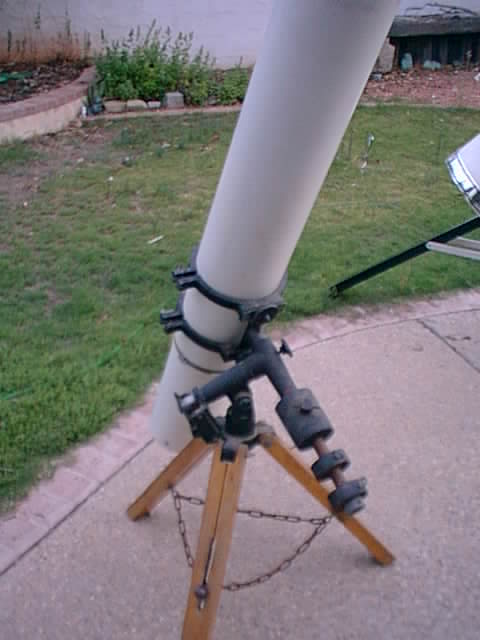
The solar telescope in an earlier form.
The sock on the focuser is to
keep the eyepiece from heating up!
Note the shadow on the ground.

A later version with the tripod shortened.
I have been observing the sun since the purchase of my first good telescope back in 1963. Those first years were spent observing with the little 2.4 inch refractor and a very dangerous eyepiece filter. As it was solar activity minimum, I soon lost interest which probably saved my eyesight. [ I will point out here that you should NEVER use an eyepiece filter without significant reduction in the sunlight, of at least 10,000:1 or more.They are EXTREMELY DANGEROUS! ] Later I projected the sun with my RV-6 for a couple years. After a stint in the Navy and a few years of getting my life back on track, I again began to get interested in solar observing again and used several small aperture refractors with the Tuthill Solar Skreen filters. These did a fine job for the apertures but I longed to see the exquisite detail seen in many of the drawings by people like Langley.
In September, 1980 an article ran on page 245 of Sky and Telescope that offered me the opportunity for such observations. The solution to the problem was so simple! With the sun the danger is the vast amount of light (and heat) available. Most people that observe the sun with night optomized telescopes. Here two enterprising amateurs simply kept the light from ever reflecting in the first place. They made a 6" Newtonian with 2 uncoated mirrors. Simple and elegant.
So I proceeded to construct a specialized telescope specifically for observing the sun. A 6" mirror was ground and polished to f/10 and left uncoated, as was the small secondary. With a 6" aperture the light reduction by having BOTH mirrors uncoated reduced the brightness to that of ambient sunlight so only a moderate filter is necessary on the eyepiece and was thus perfectly safe. It should be pointed out that the filter selected must have the specific ability to reduce infrared light (IR). This light has the greatest potential to damage the eye and since there are no pain nerves in the eye, it would not be felt. Many ordinary filters (like the Wratten series) do not filter for this and have substantial IR leaks. Welding filters do filter for IR, and they also strongly reduce the UV spectrum as well, especially heli-arc filters.
I purchased a sheet of the #8 welding filter, and using a small piece of brass tubing held in a home made rig for the drill press, cut out a disk of the filter material the correct size to fit into a screw-on eyepiece filter cell. For white light flare observing, however, I later selected an interference filter centered on the G-Band around 430 nm (nanometers) with a 18 nm bandpass. This had no infrared leak and was safe to use. But all such filters should be checked for such leaks before being used.

